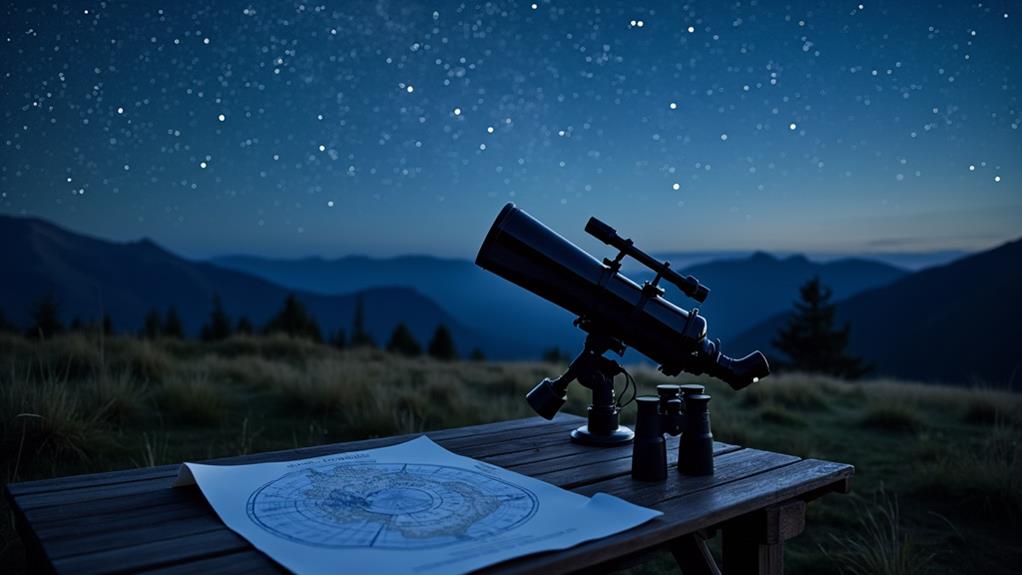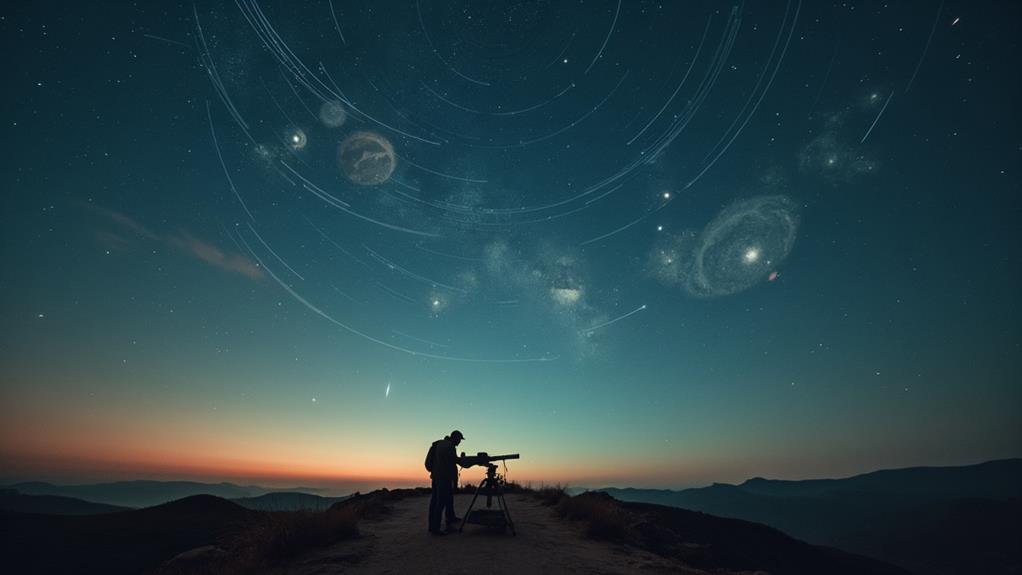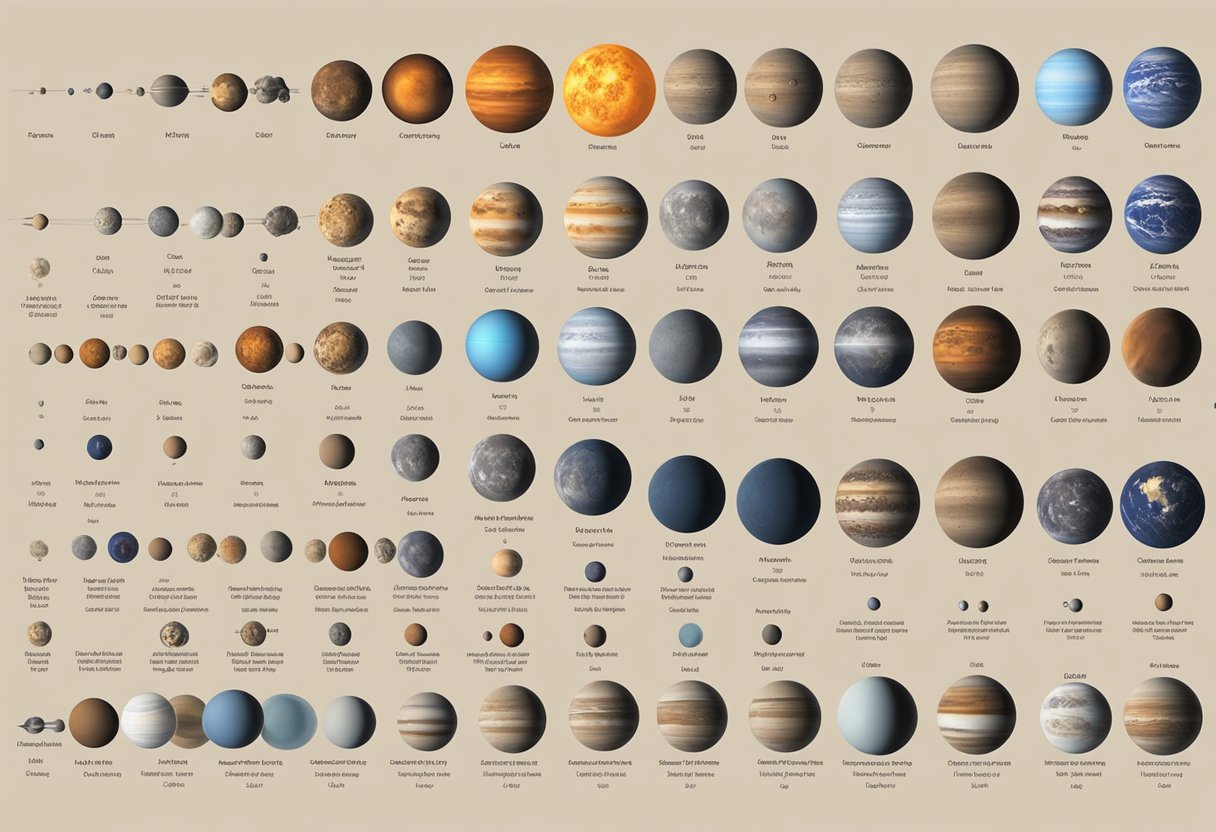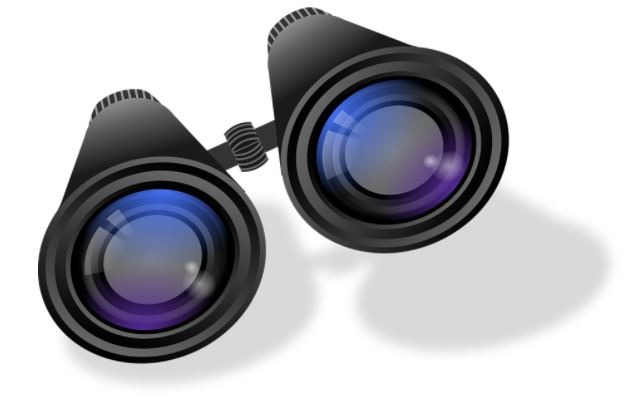Top Tips for Viewing Planetary Alignments

To view planetary alignments effectively, initially choose a dark location far from city lights. Aim for 30-45 minutes before sunrise when the sky is dark but brightening. Bring binoculars or a telescope to improve your view, and use a star chart or app for navigation. Watch the moon's position, as it can help you locate planets like Venus, Mars, and Mercury. Clear skies are crucial, so track weather conditions closely. Patience and persistence are key; sometimes ideal conditions appear after initial poor visibility. Ready to heighten your celestial experience and spot more? Here's how.
Key Takeaways
- Choose a dark, clear location away from city lights to minimize light pollution.
- Use binoculars or a telescope for better visibility of fainter planets like Uranus and Neptune.
- Plan observations 30-45 minutes before sunrise for optimal viewing conditions.
- Consult a star chart or smartphone app to accurately identify and locate planets.
- Monitor the moon's phase and position to avoid its brightness washing out fainter planets.
Understand Planetary Movements
Understanding planetary movements is vital for anyone interested in viewing planetary alignments. To grasp these celestial events, you need to know how planets, like Uranus, travel through space. Uranus, the seventh planet from the Sun, takes about 84 years to complete one orbit. This long voyage means it moves slowly across the night sky, making it easier to track over time.
When planets align, they appear to form a straight line in the night sky. This phenomenon is influenced by their orbital speeds and inclinations. For Uranus, which has an inclination of 0.773° to the ecliptic, these factors determine its position relative to other planets. You'll be able to see these alignments best under dark skies, far from city lights.
Uranus's synodic period, about 369.66 days, is the time it takes to return to the same spot relative to Earth and the Sun. This period is fundamental for predicting its position during planetary alignments. Observing these movements during oppositions, when Uranus is closest to Earth, guarantees the planet is fully illuminated and prominently visible in the night sky. Understanding these basics will improve your stargazing experience.
Best Times to Observe
Why is timing so essential when observing planetary alignments? It's because catching these celestial events at the right moment guarantees you see them at their brightest and most clearly. The best times to observe are approximately 30-45 minutes before sunrise. During this period, the sky is still dark enough for you to spot the planets with the naked eye, yet starting to brighten just enough to define their positions.
Early morning is ideal for another reason: planets in alignment often appear in the southeastern direction. So, set that alarm clock and head outside before dawn! You'll need to find a location with clear skies, free from light pollution, for the best visibility. Even a slight haze can mask the brilliance of Jupiter, Venus, Mars, Saturn, or Mercury.
Certain dates offer particularly close alignments, making the event even more spectacular. Knowing these dates in advance helps you plan your observations. Don't forget to take into account the moon phase, too. A crescent moon can serve as a helpful guide to locate the planets in alignment. So, keep an eye on lunar cycles—this little trick can make your early morning stargazing sessions even more rewarding.
Essential Equipment

To make the most out of your planetary alignment observations, having the right equipment is crucial. Start with a good pair of binoculars, which can greatly improve your ability to spot fainter planets like Uranus and Neptune. These distant planets are often difficult to see without optical aid. For a more detailed observing experience, invest in a telescope. A telescope will let you see the rings of Saturn and the surface features of Jupiter with much greater clarity due to its higher magnification.
Don't forget to have a star chart or a reliable smartphone app handy. These tools are vital for identifying key planets and their positions relative to bright stars and the moon. A comfortable reclining chair or blanket can also greatly improve your viewing experience, allowing you to observe for longer periods without strain. This is especially useful for early morning sessions when planetary alignments are often most visible.
Lastly, use red LED lights to preserve your night vision while setting up your equipment or checking your star chart in the dark. This simple addition can make a tremendous difference in the quality of your observing experience.
Identifying Planets
Identifying planets in the night sky can be an exciting and rewarding endeavor. Start with the brightest planets: Venus and Jupiter. You'll find Jupiter glowing brilliantly in the southeastern sky, while Venus, similarly bright, shines to its left. These two make excellent reference points for locating other celestial bodies.
To see Mercury, look closer to the horizon where it often appears just before dawn or shortly after sunset. Mars is next, found by tracing a line from Venus to Jupiter toward the south. Its distinct reddish hue, caused by iron oxide on its surface, makes it stand out.
Saturn, although dimmer, is also identifiable. It's best observed with a telescope to appreciate its stunning rings. You'll find it near Jupiter, with a magnitude around 1 or 0. For a challenge, locate Uranus, the seventh planet from the Sun, positioned between Venus and Mars. Binoculars and the moon's position can aid in spotting this greenish-blue planet.
Lastly, Neptune, the eighth and faintest planet, requires a telescope. It has a subtle blue hue and is positioned along the line formed by Jupiter and Saturn. Under a dark sky, these tips will help you identify these wondrous celestial bodies.
Navigating the Night Sky

After identifying the planets, the next step is steering through the night sky to observe their alignments. Early morning observations, about 30-45 minutes before sunrise, offer clearer skies and better visibility. You'll be able to spot the classical planets more easily during this time.
Start by locating Uranus. It's positioned between Venus and Mars. When Venus is prominent in the morning sky, Uranus will be close to Venus. Using reference stars like Mencar in Cetus can also help. Larger binoculars or telescopes broaden your field of view, making it easier to spot Uranus.
For Neptune, look along the line formed by Jupiter and Saturn. To navigate, identify the "hockey stick" pattern of four similarly bright stars. Neptune, with its distinctive blue hue, is close to a faint star of magnitude 7.3. Binoculars or telescopes will improve your view, ensuring Neptune is within your field of view.
Using the Moon as a Guide
The moon's predictable path and bright presence in the night sky make it an excellent tool for locating planets during alignments. By observing the moon's position, you can easily find nearby planets like Mars, Venus, and Mercury on specific dates. The moon's brightness can greatly improve the visibility of fainter planets, making it simpler to identify their locations.
For instance, if you're trying to locate Uranus or Neptune, use the moon to establish a reference line. On certain nights, you can follow the line formed by the moon and brighter planets like Jupiter and Saturn to pinpoint these distant planets. Timing is essential, so plan your observations around the moon's phases, as its position changes daily, influencing the visibility of different planets.
Binoculars can be a valuable tool when using the moon as a guide, especially during twilight hours. The increased magnification helps you spot planets that might be challenging to see with the naked eye. By leveraging the moon's predictable path and bright presence, you can efficiently navigate the night sky and enjoy the spectacular sight of planetary alignments.
Optimal Viewing Conditions

To truly appreciate planetary alignments, you'll want to observe under ideal viewing conditions. Aim to catch these celestial events approximately 30-45 minutes before sunrise; this pre-dawn window provides darker skies where planets appear more prominent and lively. Ensuring clear and dark skies is essential, so seek out locations far from city lights to avoid light pollution.
The moon's position can either improve or hinder your view. Check its phase and position relative to the planets on the specific dates you plan to observe. A bright moon can wash out fainter planets, so best viewing conditions often occur during a new moon or when the moon is below the horizon.
Early morning conditions generally offer better atmospheric stability compared to evenings, which means less atmospheric distortion and clearer views of the planets. This makes pre-dawn hours the ideal time for observation.
Improve your experience by using binoculars or telescopes. These tools are particularly useful for spotting fainter planets like Neptune and Uranus, which have lower magnitudes and require clearer skies for visibility. With these tips, you'll be well on your way to enjoying spectacular planetary alignments.
Patience and Persistence
While ideal viewing conditions set the stage for observing planetary alignments, patience and persistence truly bring the experience to life. You might need multiple mornings of persistence to spot fainter planets like Neptune, which can be challenging at an eighth magnitude. Clear skies and low horizons are crucial for visibility, especially when you're trying to locate Mercury. Since Mercury is the dimmest of the bright planets, binoculars can offer better clarity.
Start your observation sequence with Neptune and then move down to brighter planets. This approach optimizes your chances of seeing all aligned celestial bodies. The moon's position can serve as a helpful guide, as its proximity to certain planets on specific dates can improve your navigation and timing.
Enjoy the process and stay patient, even if visibility is initially poor. Conditions can improve over time, making the wait worthwhile. Remember, successful planetary observation isn't just about the right conditions but also about your commitment and perseverance. By maintaining patience and persistence, you'll find the experience of witnessing planetary alignments incredibly rewarding.
Frequently Asked Questions
How to View Planetary Alignment?
To view planetary alignments, start with planetary visibility techniques. Set up your telescope correctly, ensuring stability and focus. Choose an observing location with minimal light pollution. Use sky chart resources to plan your session and locate planets. Improve celestial event photography by adjusting camera settings for low light. Patience is key; some mornings might yield better results. Follow these steps, and you'll enjoy a stunning celestial show.
What Is the Best Time to See the Planets Align?
The best time to see the planets align is approximately 30-45 minutes before sunrise. This timing guarantees ideal viewing as the night sky is still dark and planets are prominent. Check astronomical calendars for specific celestial events and dates, like Mars on the 23rd and Venus on the 25th and 26th. Clear, dark skies improve visibility, and using the moon as a guide can help you locate these planetary alignments.
What Is the Best Way to View Planets?
Did you know Neptune has a magnitude of 7.8, making it challenging to spot without proper tools? To view planets best, adjust your telescope settings for clarity and minimize light pollution by choosing dark observation spots. Boost planet visibility by using bright celestial events as markers. Familiarize yourself with observation techniques like beginning with dimmer planets initially. Persistence and multiple attempts improve your chances of witnessing these spectacular occurrences.
What Configuration Is the Best Time to View an Inferior Planet?
To view an inferior planet, you'll want to catch it during its greatest elongation, maximizing visibility. For Mercury and Venus, this is when they're farthest from the Sun in the sky. Ideal viewing locations are those with clear, dark skies to minimize atmospheric interference. Best observation techniques include using the Moon as a guide. Timing your astronomical event correctly, like April 11, 2023, for Mercury, improves planet visibility factors.




